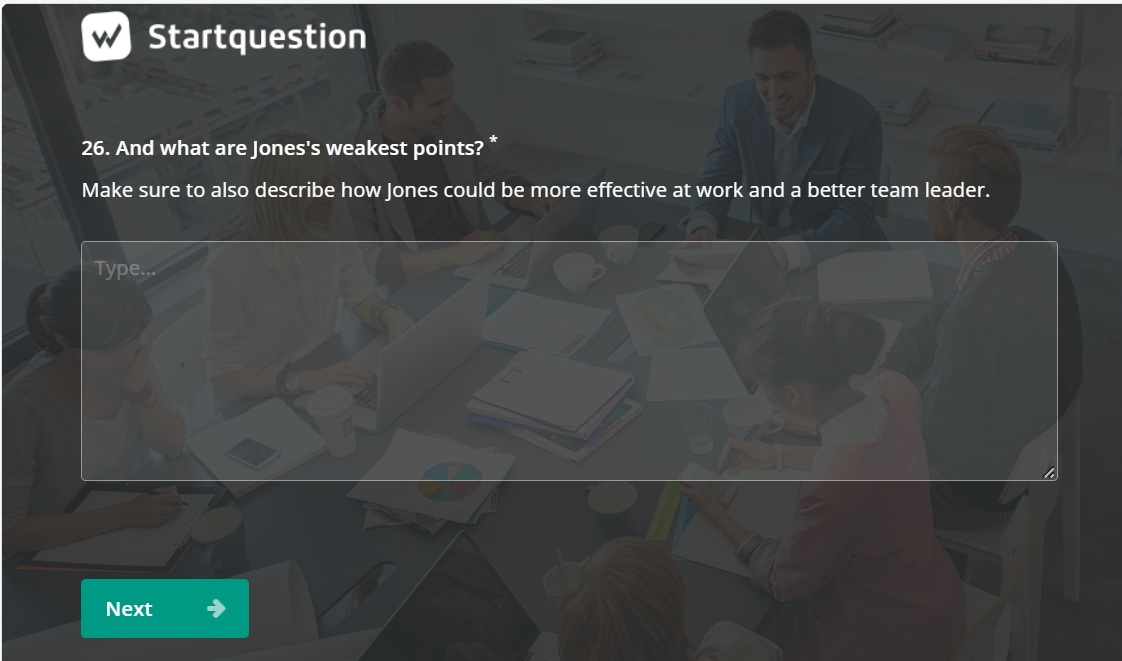Qualitative feedback is an excellent value of performance review in any organization. Constructive criticism and positive voices from other team members are effective methods of recognizing your employees’ strengths and weaknesses. In this article, I will show you how to provide 360 Degree Feedback and many benefits this study can bring to the table.
What Is 360 Degree Feedback?
The Definition of 360 Degree Feedback explains that it is a form of collecting feedback on the effectiveness of the employee’s work. Such feedback may concern the following areas: interpersonal skills, practicing company values, communication skills, professional development, employee engagement, problem solving, or leadership skills.
The employee, their superiors, subordinates, and colleagues (sometimes clients) provide feedback in the study. It is a process of comparing a self-assessment of specific skills with the assessment of those skills by other people who observe the performance of the assessed person daily from different but still very important perspectives.
360 Degree Survey
If you want to be a good leader, you have to be open to criticism. Without knowing your strong and weak sides it will be extremely difficult for you to develop and make your company achieve success.
360 Degree Survey
If you want to be a good leader, you have to be open to criticism. Without knowing your strong and weak sides it will be extremely difficult for you to develop and make your company achieve success.
Types of the Constructive Feedback in the Study
Before we move on to the examples of 360 Degree Feedback, it’s worth learning more about the two types of peer insights we can get during the survey.
360 Degree Evaluation Method distinguishes two types of feedback: reinforcing and redirecting. The first one concerns situations when we want to praise someone for the high quality of performed duties and positively impact employee motivation. Contrarily, we use redirecting feedback when we want constructive criticism to translate into improved commitment and quality of work.
Let’s see examples of what such honest feedback can look like in open ended questions.
Reinforcing (Positive) Feedback Examples
Employee feedback from a specific team member is essential to performance reviews (Pulse Surveys are another useful tool for collecting feedback) Not only is it a tool for assessing core competencies but also an effective way to solve problems, improve the atmosphere in the team, and “build” a committed employee. Try to highlight other team members’ accomplishments or attitudes in case of:
Completing a Specific Project
Management based solely on rebuking subordinates for inferior results is a thing of the past. Praising employee performance is a part of leadership skills and an excellent opportunity to strengthen the team’s motivation. The same goes for praising your colleagues. Don’t spare praise if someone has earned it.
Feedback Example For Performance Review:
Congratulations, Lindsay! Because of your great work and commitment, our latest marketing campaign has attracted many new customers to the company. Fantastic job, thank you!
New Ideas & Creative Solutions
Appreciate the employee who takes the initiative in team meetings and submits exciting ideas. Refrain from quenching your people’s enthusiasm. Such positive approach can help solve problems, or come up with a new solution for the product to help increase profits.
Good Feedback Example for 360 Degree Survey:
Josh, thank you for your curious questions during the last product demo meeting. I also like your great ideas regarding our company’s podcast. Very inspirational for all of us.
Both positive and negative feedback can be good for any organization. The 360-degree evaluation is an excellent tool for appreciating a colleague (subordinate or superior) and communicating constructive criticism.
Helping Others At Work & in Employee Development
A good team spirit is the treasure of every organization. It is a person who cares about a good atmosphere but also cares for others. Someone willingly helped with your problem, even though it was beyond their responsibilities? Or they made sure that new hires did not feel bad at work? Appreciate their attitude in coworker review.
Colleague performance feedback example:
Rachel, I can express how grateful I am for your help with new employees. It was very kind of you to show them what our company’s culture is all about. I bet you make the onboarding process for them as smooth as possible. Thank you!
Strengthening Employee’s Motivation and Confidence
We all have a bad day at work, a failed project, or a nightmare speech at a conference. Do you need to meet deadlines but fail from time to time? Well, that’s life. Keep it in mind if you find someone on your team who needs support. Provide employee feedback to help the person get back on their feet.
In the end, you’d expect the same thing in their shoes, wouldn’t you?
360 feedback examples for peers:
I know you put a lot of effort into preparing the presentation for the conference. Performing on stage is highly nerve-wracking. Don’t worry if not everything went your way. Your presentation is excellent material that our marketing department will surely use. If you want, I will talk to the HR department about the budget for public speaking training. Thanks again for your outstanding work.

Employees Performance Outside the Job
In a 360-degree feedback survey, we can focus on more than just performance management and direct reports regarding employees’ career development. Moreover, such a review system is also a unique opportunity to highlight co-workers that engage in social issues or help local communities.
Positive Appraisal Example For The Survey:
Marie, thank you for organizing the collection of food and warm blankets for the animal shelter in the company. You are an inspiration to me and proof of how the big heart of an individual can change the fate of dozens of stray dogs and cats. You can count on me for next fundraisers. Thanks!
Redirecting (Negative) Feedback Examples
Similarly to employee recognition, in the 360-degree feedback survey, we express criticism.
Evidently, it is much easier to give anonymous feedback, but when we do it constructively and gently, we can try to do so openly. Remember that the purpose of such feedback is not to offend the coworker but to resolve conflicts and indicate areas that should be improved so that your cooperation returns in the right direction.
Here are negative feedback examples for colleagues.
Employee Missed Deadline or Failed Project… Again
Hand up; who has never missed a deadline at work? I thought so.
The problem begins when an employee regularly fails to meet deadlines, neglects their duties, doesn’t conduct their tasks effectively, or does not give high priority to the most critical projects.
Negative 360 feedback example:
Mike, I’m sorry to write this. Because of your design delays, we lost our chances of winning the tender. If you know you will miss the time, please report it in advance so we can organize the tasks differently.
Constructive criticism and positive voices from other team members are effective methods of recognizing your employees’ strengths and weaknesses.
Quiet Quitting & Disengaged Coworker
We value work-life balance. However, this idea does not mean a low commitment to our duties’. On the contrary, in an ideal scenario, the idea is to deliver what we have committed to during working hours in a good atmosphere, and after hours to devote ourselves to family, hobbies, and everything unrelated to work.
Is every employee motivated? Of course not! But the negative attitude of an individual can destructively affect the team’s work. Therefore, it is worth monitoring employee engagement and satisfaction and investing time and resources in problem-solving.
Example of redirecting feedback:
Sarah, I have recently noticed an apparent decrease in motivation, which translates into the results for the entire sales department. Is everything OK? Remember that you can always talk to me. Let’s find a solution to this situation together.
Employee is Not a Team Player
Only some people are predisposed to act like a group leader (it’s related to individual interpersonal skills). But the way each employee collaborates with another has a significant influence on the team. Suppose a coworker does not play for the group’s success, disregards the cooperation and responsibilities of other participants, and ultimately claims the project’s success.
You can enjoy watching Colin Robinson, a brilliant energy vampire in the “What We Do In The Shadows” tv series, but you don’t want to see such a person daily at work. The same applies to people with low personal culture or those who create new ones instead of resolving conflicts.
360 Degree Feedback Example:
I know that you are a good programmer and fulfill your duties, but disrespectful and unpleasant comments towards colleagues have a terrible effect on the atmosphere in the group. Don’t focus solely on your tasks. Let’s work together to develop not only individually but as a team.
Lack of Communication Skills
In mature organizations, the culture of feedback matters. It applies, among other things, to development work and meetings. If we know our coworkers well, we know which of them have many exciting ideas.
Do they sit quietly at meetings? Let’s mention it in the peer review to encourage them to take the floor.
Examples of Team Members Opinions:
Hey Rick, I love your latest direct reports on market research. Great job! You have plenty of insights to share during our meetings. What makes you stay silent? We’d love to hear your voice; if communication is a challenge for you, PM me. Can we organize a workshop for you?

The Employee Is Constantly Late
Getting started at a specific time can be troublesome. Sometimes our bus misses, in the winter, the battery in the car will run out, or we will be stuck in kindergarten for a long time, taking the children off in the morning.
We can explain everything. But it’s hard to justify a coworker who is notoriously late for work and shows up at meetings when they started already. It’s just disrespectful to everyone.
Example Way to Communicate Negative Feedback:
I appreciate the fulfillment of your responsibilities and willingness to help others at work, but I have serious reservations about your approach to punctuality. Everyone would be better off if you came to work on time, and the atmosphere at meetings would only benefit if you didn’t go in there with your coffee five minutes after starting. Please, keep it in mind.
A Checklist for Thoughtful 360 Degree Feedback
Both positive and negative feedback can be good for any organization. The 360 degree evaluation is an excellent tool for appreciating a colleague (subordinate or superior) and communicating constructive criticism.
We have prepared a checklist of how to proceed, so that performance reviews bring the most significant value to the company and repair interpersonal relations.
How to Give Positive and Critical Reviews:
- Be respectful of the other person, even if you want to express only criticism
- Peers review is not racing. Think about and plan your answer carefully
- Speak for yourself. It is your feedback and your emotions, not the feelings of the group
- Give precise answers to specific questions, control the chaos of thoughts
- Be honest. Remember that openly speaking is better than anonymous feedback
- Don’t forget about diplomacy, but be firm when necessary
Ready to give or gather impactful employee feedback?




